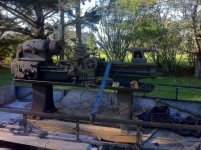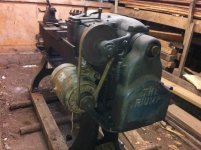FarmRepairs
Plastic
- Joined
- Jul 29, 2014
- Location
- New Zealand
Hello, I have some questions about a newly acquired Colchester Triumph I have here. The attached photo's show it in the condition I got it in and I figure it is at least 1930's/1940's era but I would like to pin down a bit more detail if possible. Does anyone know what/when this lathe is? Because of the screw cutting gearbox and power feed carriage and lack of clutch or brake levers on the headstock, it does not seem to match any of the photo's on the lathes.co.uk website. Also, the pulley arrangement at the back has an extra support on the non-driving end of the shaft that is not there on any of the other photo's I can find on the web. Even further, the selector lever for the thread cutting comes out from the bottom of the gearbox, not the side like all the others I can find.
I haven't yet found a serial number, partly because it is filthy and partly because I haven't looked hard enough yet. I was hoping someone might recognize the general model and accessories though. Are these any good?
It came with metric screw cutting threads and has a tumble reverse lever . The motor temporarily fitted to it is only 1hp but this is much to small and can't even run it up to full speed in the high gears with no load.
Thanks in advance.
I haven't yet found a serial number, partly because it is filthy and partly because I haven't looked hard enough yet. I was hoping someone might recognize the general model and accessories though. Are these any good?
It came with metric screw cutting threads and has a tumble reverse lever . The motor temporarily fitted to it is only 1hp but this is much to small and can't even run it up to full speed in the high gears with no load.
Thanks in advance.










